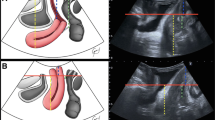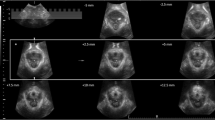Abstract
Introduction and hypothesis
The study aims were to evaluate (1) the interobserver and (2) the interdisciplinary repeatability of levator hiatus, urethral thickness, and anorectal angle measurements using three-dimensional endovaginal ultrasound (3D-EVUS).
Methods
Twenty-seven nulliparous asymptomatic females were imaged with 3D-EVUS. Analyses were conducted off-line from stored 3D volumes by six readers (two radiologists, two urogynecologists, and two colorectal surgeons) using a standardized technique. Reproducibility was determined using the interclass correlation coefficients (ICC).
Results
The overall interobserver repeatability for levator hiatus dimensions was good to excellent (ICC, 0.655–0.889), for urethral thickness was good (ICC, 0.624), and for anorectal angle was moderate (ICC, 0472). The interdisciplinary repeatability for levator hiatus indices was good to excellent (ICC, 0.639–0.915), for urethral thickness was moderate to good (ICC, 0.565–0.671), and for anorectal angle was fair to moderate (ICC, 0.204–0.434).
Conclusions
3D-EVUS yields reproducible measurements of levator hiatus dimensions and urethral thickness in asymptomatic nulliparous women.



Similar content being viewed by others
References
Groenendijk AG, Birnie E, Boeckxstaens GE, Roovens JP, Bonsel GJ (2009) Anorectal function testing and anal endosonography in the diagnostic work-up of patients with primary pelvic organ prolapse. Gynecol Obstet Investig 67:187–194
Groenendijk AG, Birnie E, de Blok S, Adriaanse AH, Ankum WM, Roovens JP et al (2009) Clinical-decision taking in primary pelvic organ prolapse; the effects of diagnostic tests on treatment selection in comparison with a consensus meeting. Int Urogynecol J 20:711–719
Kaufman HS, Buller JL, Thompson JR, Pannu HK, DeMeester SL, Genadry RR et al (2001) Dynamic pelvic magnetic resonance imaging and cystocolpodefecography alter surgical management of pelvic floor disorders. Dis Colon Rectum 44:1575–1584
Tunn R, Schaer G, Peschers U (2005) Update recommendations on ultrasonography in urogynecology. Int Urogynecol J 16:236–241
Dietz HP, Steensma AB (2005) Posterior compartment prolapse on two-dimensional and three-dimensional pelvic floor ultrasound: the distinction between true rectocele, perineal hypermobility and enterocele. Ultrasound Obstet Gynecol 26:73–77
DeLancey JOL (2005) The hidden epidemic of pelvic floor dysfunction: achievable goals for improved prevention and treatment. Am J Obstet Gynecol 192:1488–1495
Santoro GA, Wieczorek AP, Stankiewicz A, Wozniak MM, Bogusiewicz M, Rechberger T (2009) High-resolution three-dimensional endovaginal ultrasonography in the assessment of pelvic floor anatomy: a preliminary study. Int Urogynecol J 20:1213–1222
Uebersax JS, Wyman JF, Shumaker SA, Mc-Clish DK, Fanti JA (1995) Short forms to assess life quality and symptom distress for urinary incontinence in women: the incontinence impact questionnaire and the urogenital distress inventory. Continence program for women research group. Neurourol Urodyn 14:131–139
Rockwood TH, Church JM, Fleshman JW, Kane RL, Mavrantonis C, Thorson AG et al (1999) Patient and surgeon ranking of the severity index. Dis Colon Rectum 42:1525–1532
Altomare DF, Spazzafumo L, Rinaldi M, Dodi G, Ghiselli R, Piloni V (2008) Set-up and statistical validation of a new scoring system for obstructed defecation syndrome. Colorectal Dis 10:84–88
Mouritsen L, Larsen JP (2003) Symptoms, bother and POPQ in women referred with pelvic organ prolapse. Int Urogynecol J Pelvic Floor Dysfunction 14:122–127
Laycock J (1994) Clinical evaluation of the pelvic floor. In: Schuessler B (ed) Pelvic floor re-education: principles and practice. Springer, London, pp 42–48
Bump R, Mattiasson A, Bo K, Brubaker L, DeLancey J, Klarskov P et al (1996) The standardization of terminology of female pelvic organ prolapse and pelvic floor dysfunction. Am J Obstet Gynecol 175:10–17
Dietz HP, Shek C, Clarke B (2005) Biometry of the pubovisceral muscle and levator hiatus by three-dimensional pelvic floor ultrasound. Ultrasound Obstet Gynecol 25:580–585
Majida M, Braekken IH, Umek W, Bo K, Saltyte Benths J, Ellstrom Engh M (2009) Interobserver repeteability of three- and four-dimensional transperineal ultrasound assessment of pelvic floor muscle anatomy and function. Ultrasound Obstet Gynecol 33:567–573
Landis JR, Koch GG (1997) The measurement of observer agreement for categorical data. Biometrics 33:159–174
Shrout PE, Fleiss JL (1979) Intraclass correlations: uses in assessing rater reliability. Psychol Bull 86:20–428
Altman DG (1999) Practical statistics for medical research. Chapman and Hall, London
Hoyte L, Brubaker L, Fielding JR, Lockhart ME, Heilbrun ME, Salomon CG et al (2009) Measurements from image-based three dimensional pelvic floor reconstruction: a study of inter- and intraobserver reliability. J Magn Reson Imaging 30:344–350
Weinstein MM, Jung SA, Pretorious DH, Nager CW, den Boer DJ, Mittal RK (2007) The reliability of puborectalis muscle measurements with 3-dimensional ultrasound imaging. Am J Obstet Gynecol 197:68e1–68e6
Conflicts of interest
No funding was accepted or involved in this project. Author GAS has received speaker’s fees from BK Medical. He has also received equipment loans from BK Medical and General Electric (GE) for research purposes. Author APW has received speaker’s fees from BK Medical. He has also received equipment loans from BK Medical and GE for research purposes. Author SAS has received research grants from AMS, BK Medical, Medtronics, and Uroplasty Inc. He is an anatomy consultant for AMS. Author ERM has received speaker’s fees from BK Medical, Allergan, and Pfizer. She has also received equipment loans from BK Medical for research purposes.
Author information
Authors and Affiliations
Corresponding author
Rights and permissions
About this article
Cite this article
Santoro, G.A., Wieczorek, A.P., Shobeiri, S.A. et al. Interobserver and interdisciplinary reproducibility of 3D endovaginal ultrasound assessment of pelvic floor anatomy. Int Urogynecol J 22, 53–59 (2011). https://doi.org/10.1007/s00192-010-1233-y
Received:
Accepted:
Published:
Issue Date:
DOI: https://doi.org/10.1007/s00192-010-1233-y




